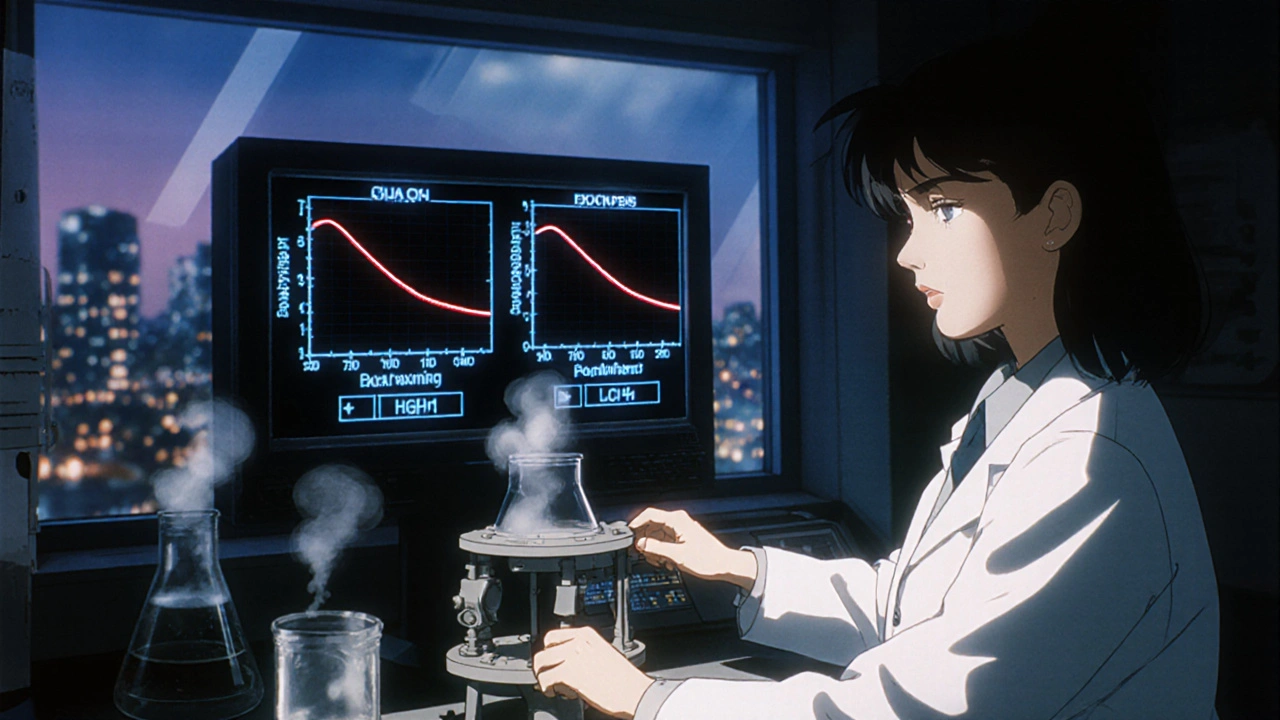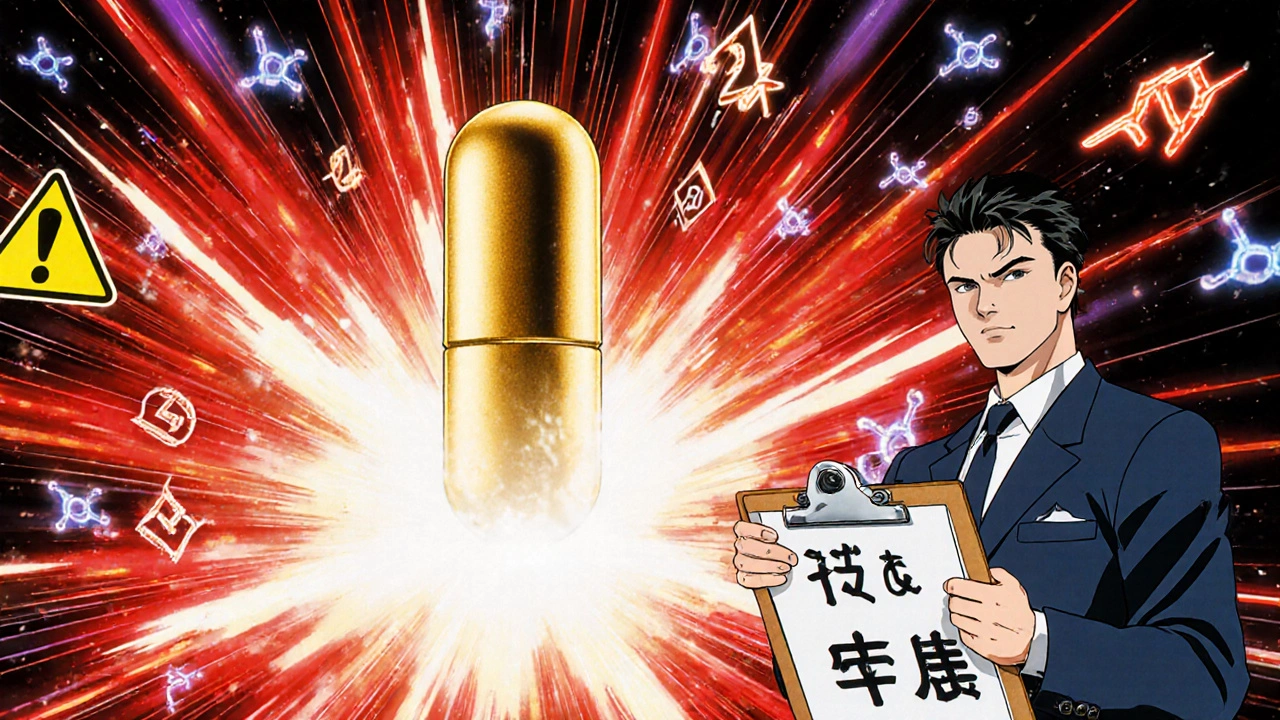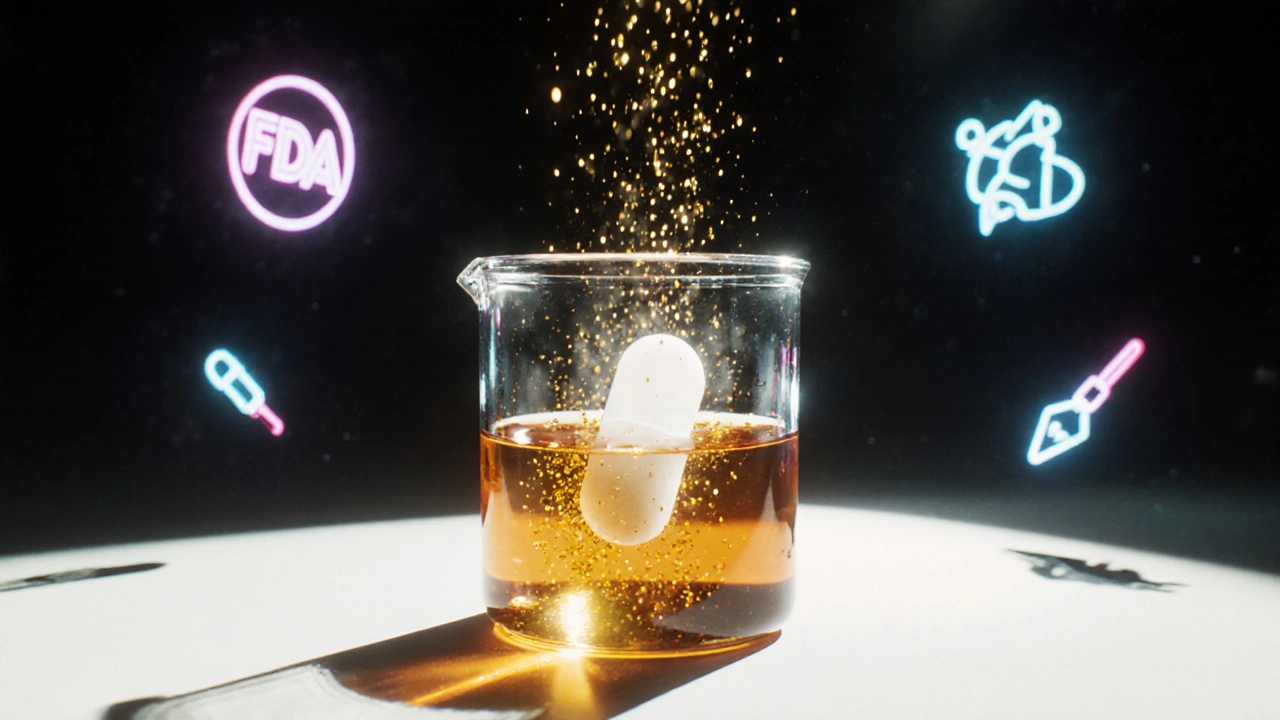When you pick up a generic pill at the pharmacy, you expect it to work just like the brand-name version. But how does the FDA make sure it does? The answer lies in dissolution testing-a quiet but powerful tool that checks whether a generic drug releases its active ingredient at the same rate and amount as the original. This isn’t guesswork. It’s science, tightly regulated, and absolutely critical to patient safety.
Why Dissolution Testing Matters
Dissolution testing measures how quickly a drug dissolves in a liquid under controlled lab conditions. Think of it like watching a sugar cube melt in water. For pills, the goal is to see how fast the active ingredient-say, ibuprofen or metformin-comes out of the tablet and into the fluid. If it dissolves too slowly, the body won’t absorb enough. Too fast, and you risk side effects or even toxicity. The FDA uses this test because it’s a reliable stand-in for what happens inside the human body. Doing human bioequivalence studies for every single generic drug would be expensive, slow, and unethical. Instead, dissolution testing acts as a proxy. If two drugs dissolve the same way in the lab, they’re likely to behave the same way in the bloodstream. This isn’t optional. For every generic oral solid drug submitted for approval, the FDA requires detailed dissolution data. That includes immediate-release tablets, extended-release capsules, and even suspensions. But not everything needs it. If a drug is already in liquid form-like cough syrup or eye drops-it doesn’t need dissolution testing because it’s already dissolved.The Five Requirements for Approval
The FDA doesn’t just ask for a single number. It demands five specific types of data to approve a generic drug:- Solubility of the active ingredient-How well does the drug dissolve in water or stomach fluid?
- Test conditions-What equipment is used? At what speed? What pH? How much liquid? The FDA requires specific details, like using USP Apparatus 1 or 2, rotating at 50-100 rpm, and using 900 mL of buffer solution.
- Method validation-Is the test accurate? Can it measure the exact amount of drug released? This includes checking for interference from other ingredients in the pill.
- Robustness-What happens if you change one variable? A little more acid? A slower stir? The method must still work reliably.
- Discriminatory power-Can the test tell the difference between a good and bad version of the drug? This is especially important for tricky drugs like those with low solubility or complex release profiles.
What Counts as ‘Good’ Dissolution?
There’s no one-size-fits-all answer. But for most immediate-release pills, the FDA expects at least 80% of the drug to dissolve within 45 minutes. For some drugs, it’s 30 minutes. For others, it’s a multi-stage test. The FDA’s 2018 guidance simplified things for high-solubility, high-permeability drugs (BCS Class I). For these, a single-point test at 30 minutes using 0.1N HCl is often enough. That’s because these drugs dissolve easily and are absorbed reliably. The FDA even allows a “biowaiver”-meaning no human testing is needed if the dissolution profile matches the brand-name drug. But for low-solubility drugs (BCS Class II), things get complicated. These drugs don’t dissolve well, so the test must be sensitive enough to catch small differences in formulation. That’s why the FDA requires multi-point testing and proof that the method can distinguish between good and bad batches.
Comparing Profiles: The f2 Factor
It’s not enough to say “both drugs dissolve 80% in 45 minutes.” You have to show that their entire release pattern is similar. That’s where the f2 similarity factor comes in. The f2 test compares the dissolution profiles of the generic and brand-name drug across multiple time points-say, 10, 20, 30, 45, and 60 minutes. If the two curves look almost identical, the f2 value will be high. The FDA considers an f2 score of 50 or above as statistically equivalent. Below 50? That’s a red flag. The manufacturer must explain why the difference doesn’t affect safety or effectiveness. This isn’t just math. It’s a visual check. If the brand-name drug releases 20% at 15 minutes, the generic must be close-say, 18% to 22%. A 40% release at 15 minutes? That’s a problem. The body can’t handle that kind of spike.Special Cases: Extended-Release and Alcohol Risks
Extended-release pills are designed to release medication slowly over hours. If they fail, they can dump their entire dose at once-called “dose-dumping.” That’s dangerous. To prevent this, the FDA requires testing under multiple pH levels (1.2, 4.5, and 6.8) to simulate different parts of the digestive tract. There’s also alcohol challenge testing. Many extended-release drugs are tested with up to 40% ethanol. Why? Because people drink alcohol. And if a pill releases all its drug when mixed with beer or wine, that’s a public health risk. In 2023, the FDA rejected an ANDA for an extended-release opioid because the generic version released 60% of its drug in 2 hours with 40% ethanol-while the brand-name version released only 25%. That difference wasn’t acceptable. The manufacturer had to redesign the formulation.The FDA’s Dissolution Database
Manufacturers don’t start from scratch. The FDA maintains a public Dissolution Methods Database with over 2,800 tested methods for specific drugs. If your generic is a version of a drug already in the database, you can follow the recommended method. This saves months of development time. But if your drug isn’t listed-or if the reference product’s method isn’t publicly available-you must develop your own. That’s expensive. Some companies spend 6 to 12 months just perfecting the test. And then they have to submit 50 to 100 pages of documentation in their ANDA application. The FDA reviews every detail. They don’t just check the numbers. They ask: Why did you choose this pH? Why this rotation speed? Did you test for interference from fillers? Did you prove the method works under stress? If the answer isn’t thorough, the application gets a request for more data.
Post-Approval Changes
Even after approval, the FDA doesn’t let up. If a company changes its manufacturing site, switches suppliers, or tweaks the formula-even slightly-they must prove the dissolution profile hasn’t changed. This is called SUPAC-IR (Scale-Up and Post-Approval Changes for Immediate Release products). A change in the type of magnesium stearate used as a lubricant? That could alter how fast the tablet breaks down. The company must run comparative dissolution tests and submit the data. If the f2 score drops below 50, the FDA can demand a new bioequivalence study-or even pull the product off the market. This isn’t hypothetical. In 2022, a generic metformin product was recalled after post-approval testing showed its dissolution profile shifted after a supplier change. Patients reported reduced effectiveness. The company had to revalidate the method and resubmit.What’s Next?
The FDA is pushing toward more physiologically relevant testing-methods that better mimic the human gut. Right now, most tests use simple buffers. But real stomach fluid is more complex. Future tests might include enzymes, bile salts, and varying temperatures to get a truer picture. There’s also talk of expanding biowaivers to BCS Class III drugs-those with high solubility but low permeability. If proven safe, this could cut development time for hundreds of generics. But the core rule stays the same: dissolution testing must be product-specific. You can’t copy someone else’s method and call it good. Every drug has unique chemistry. Every formulation has unique risks. The FDA’s job isn’t to make approval easy-it’s to make sure it’s safe.For patients, this means peace of mind. For manufacturers, it means rigor. And for the system, it means trust-built not on promises, but on data, method, and measurable results.
What is dissolution testing in generic drugs?
Dissolution testing is a lab procedure that measures how quickly a drug releases its active ingredient from a tablet, capsule, or suspension under controlled conditions. For generic drugs, it’s used to prove they behave the same way in the body as the brand-name version, without needing human studies.
Why does the FDA require dissolution testing for generics?
The FDA requires dissolution testing because it’s a reliable, non-invasive way to predict whether a generic drug will work like the brand-name version. It replaces the need for costly and time-consuming human bioequivalence studies for most oral solid drugs, while still ensuring safety and effectiveness.
What is the f2 similarity factor?
The f2 similarity factor is a statistical tool used by the FDA to compare the dissolution profiles of a generic drug and its brand-name counterpart. An f2 score of 50 or higher means the two profiles are similar enough to be considered bioequivalent. Scores below 50 require further justification.
Do all generic drugs need dissolution testing?
No. Dissolution testing is required for oral solid dosage forms like tablets and capsules, as well as oral suspensions and semi-solids. It’s not needed for drugs already in solution, such as oral liquids, eye drops, or topical creams, because they don’t need to dissolve in the body.
What happens if a generic drug fails dissolution testing?
If a generic fails dissolution testing, the FDA will not approve it. The manufacturer must revise the formulation, retest, and resubmit. In some cases, even approved generics are recalled if post-market testing shows their dissolution profile has changed due to manufacturing changes.
Can a generic drug have different dissolution specs than the brand-name drug?
Yes, but only if the FDA determines that the difference doesn’t affect safety or effectiveness. This is rare and usually happens when the generic drug has a different excipient profile that still delivers the same therapeutic outcome. The FDA may set different acceptance criteria based on real-world data from approved ANDAs.


Deepa Lakshminarasimhan
November 14, 2025 AT 11:23so like... what if the FDA just got pressured to approve generics because pharma companies bribed them with fancy vacations? i mean, look at how fast some of these got approved during the pandemic. they skipped half the tests. i’ve seen my generic metformin make me dizzy-brand name never did. coincidence? i think not. 🤔
Erica Cruz
November 16, 2025 AT 10:55Ugh. Another ‘FDA is great’ fanfic. The dissolution testing? It’s a glorified sugar cube experiment. Real bioavailability? You need blood draws, not a beaker and a stir bar. And don’t get me started on how they let companies cherry-pick pH conditions to make their junk look good. This isn’t science-it’s regulatory theater.
Johnson Abraham
November 18, 2025 AT 02:13lol who even cares if the pill dissolves in 30 or 45 min? i take mine with a beer and it still works. the fda is just trying to make us pay more. also, f2? sounds like a bad video game. 🤷♂️
Shante Ajadeen
November 19, 2025 AT 03:47This is actually really reassuring to read. I’ve always wondered how generics are checked and it’s wild to think there’s this whole science behind something so simple. I’m glad someone’s watching the store. Thanks for breaking it down so clearly!
dace yates
November 20, 2025 AT 18:30Wait, so if a drug is already in liquid form, they skip dissolution testing? But what about absorption differences in the gut? Doesn’t that matter more than whether it’s dissolved in a lab? Just curious.
Danae Miley
November 22, 2025 AT 06:42The f2 similarity factor is not a ‘tool’-it’s a statistically validated metric with defined acceptance criteria. If you’re going to critique dissolution testing, at least understand the math behind it. The FDA doesn’t guess. They calculate. And your anecdotal ‘I felt different’ isn’t evidence.
Charles Lewis
November 23, 2025 AT 23:24It’s worth noting that the entire framework of dissolution testing evolved from decades of pharmacokinetic research, beginning with the Biopharmaceutics Classification System in the 1990s. The FDA’s approach is not arbitrary-it’s a harmonized international standard, adopted by EMA, Health Canada, and PMDA. What we’re seeing here is the convergence of regulatory science, industrial quality control, and patient safety, all distilled into a single, measurable parameter. To dismiss it as ‘bureaucratic red tape’ is to misunderstand the very foundation of modern pharmaceutical regulation.
Renee Ruth
November 25, 2025 AT 11:07They rejected an opioid generic because it released 60% with alcohol? That’s terrifying. But guess what? The brand-name version? It’s still on the market. And people are drinking while taking it. Who’s really protecting us here? The FDA? Or the corporate lawyers?
Samantha Wade
November 26, 2025 AT 01:01Thank you for highlighting the SUPAC-IR guidelines. This is critical. Many people don’t realize that even a minor change in lubricant can alter dissolution kinetics. The FDA’s post-approval vigilance is what prevents another Vioxx situation. We should be grateful for this rigor-not cynical about it.
Elizabeth Buján
November 27, 2025 AT 12:54It’s wild how much thought goes into something we just swallow without thinking. I used to think generics were just cheaper copies. Now I see they’re like clones made with precision-same DNA, same function, but built by a different team. And the fact that they test for alcohol interactions? That’s next-level care. We’re lucky to have this system.
Andrew Forthmuller
November 28, 2025 AT 16:17so f2 < 50 = bad. got it. thanks for the tl;dr.
vanessa k
November 29, 2025 AT 20:14I’ve been on the same generic for 5 years. Last month, my refill felt different-like it wasn’t working as well. I switched back to brand and felt normal again. I didn’t say anything until now. Maybe I’m not crazy. Maybe the manufacturer changed something and didn’t tell anyone. This post makes me feel less alone.